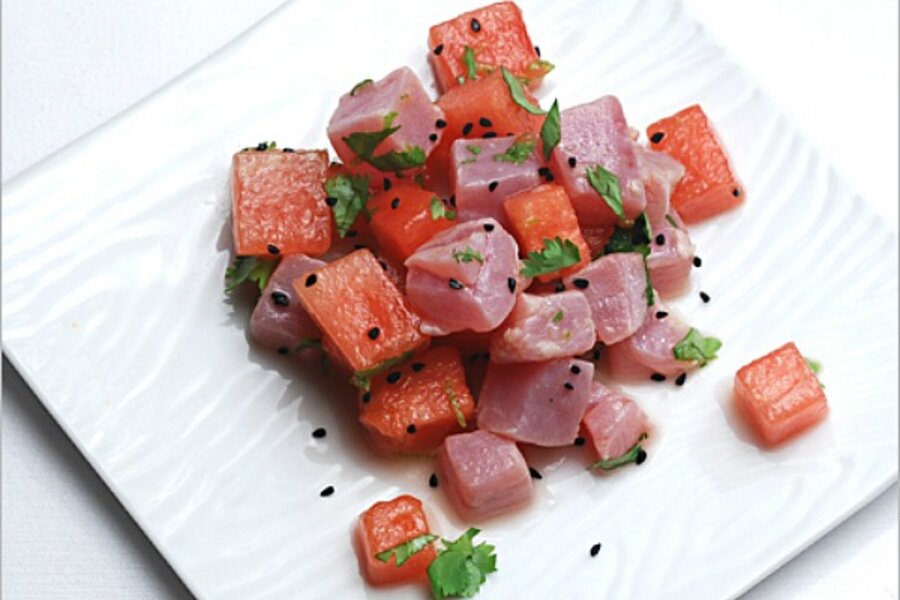Watermelon tuna ceviche
Loading...
As American psychology professor Abraham Maslow once said, when all you have is a hammer, everything looks like a nail. Los Cabos, at the southernmost tip of Mexico’s Baja California Peninsula, is surrounded on three sides by water. To the lucky inhabitants there, everything looks like a seafood buffet.
I saw this firsthand on a recent culinary press trip to Los Cabos (yes, I’m on about that again). Did you know that there are flights at 5:30 in the morning? Me neither. But being on one meant I grabbed an airport breakfast sandwich and cursed when a mad dash for my connecting flight in Atlanta precluded getting something more. So late afternoon found me at my hotel, the Grand Solmar Land’s End Resort & Spa, desperate for a light meal to tide me over until the group dinner. I found it at the hotel’s oceanside restaurant, La Roca. It was called, quite simply, Seafood from the Pacific.
And it was perfect. Shrimp, octopus, lobster and bay scallops, all impossibly fresh, poached and served cold with celery, avocado, cucumber, red onion and a citrus vinaigrette. I ate it on the restaurant veranda, with maybe 50 yards of beach between me and the crashing waves of the Pacific Ocean, smelling the salt air and understanding a whole new kind of farm to table.
The next day, I got an even closer understanding, as my fellow travelers and I walked along the marina in Cabo San Lucas at 6:30 in the morning, on our way to a fishing boat that would take us out onto the Sea of Cortés, around the tip of the Baja Peninsula and out onto the Pacific Ocean.
The fishing boat in question was the Linda Fiesta, a 26-footer from Top Anglers Sportfishing. I’m pretty sure the captain was Ernesto and the mate, Enrique. But it could have been the other way around – it was, after all, 6:30 in the morning.
Top Anglers offers big game fishing trips that take you over the horizon, beyond sight of land, for sailfish and other trophy fish. But we were fishing for lunch. We stayed within sight of the shore and within a few hours, had reeled in an impressive catch of bonita, mid-sized, predatory members of the mackerel family, related to tuna.
When we got back to the marina, the ever resourceful Rose (our host for the trip) found someone to clean the fish, feeding the skeletons and heads to waiting pelicans, sometimes scratching them on the heads like puppies. Then we were off to the Wyndham Cabo San Lucas Resort, a short walk across the marina. Our catch was whisked away to the kitchen, and we toured the resort.
A short while later, we settled into a long outdoor table at the hotel’s outdoor No Worries restaurant, overlooking the marina, for a leisurely lunch featuring bonita prepared three ways. All were delicious, but the one that really caught my eye was a ceviche with cubes of watermelon that mimicked the red-fleshed fish and tiny black charnushka seeds filling in for the absent watermelon seeds.
Ceviche is a seafood dish in which raw seafood is marinated in citrus juice – usually lemon or lime or both. The juice “cooks” the fish and produces a fresh, clean taste. Ceviche is perfect for summertime entertaining, because you don’t heat up the kitchen.
This recipe is my take on the colorful, fresh flavored appetizer we had at the Wyndham. I substituted easier-to-find fresh tuna for the bonita. Since the fish is barely “cooked” by curing with citrus juice for a few minutes, it must be absolutely fresh. Ask for sushi-grade tuna and don’t be afraid to ask to give it a sniff test.
Tuna Watermelon Ceviche
Serves 4 to 6 as a first course
1/2 pound sushi-grade tuna
4 tablespoons fresh lime juice (about 2 limes)
1 tablespoon fresh lemon juice
1-1/2 teaspoons extra virgin olive oil
3/4 teaspoon fine sea salt
small seedless watermelon
2 tablespoons chopped cilantro, divided
the zest of 1 lime
1 teaspoon or more charnushka seeds (also called nigella seeds – see Kitchen Notes)
Before preparing ceviche, place tuna in the freezer for 45 minutes to an hour. This will make it easier to slice. So will a really sharp knife.
Meanwhile, mix lime juice, lemon juice, olive oil and salt in a small bowl. Set aside. Cut enough watermelon into a 1/3-inch dice to produce a generous 1-1/2 cups. Refrigerate. When tuna is sufficiently chilled, cut into a 1/3-inch dice. You should have about 1-1/2 cups.
Assemble the ceviche. Combine tuna, watermelon, lime zest, 1-1/2 tablespoons cilantro and about 3/4 teaspoon charnushka seeds in a mixing bowl. Whisk citrus juice mixture and pour over tuna mixture. Stir gently to combine, being careful not to crush watermelon cubes. Let rest for a scant two minutes, stir once more and plate, using a slotted spoon to drain liquids. Top with remaining cilantro and charnushka seeds. Serve immediately.
Kitchen Notes
Whatever you call them, you need these seeds. Charnushka seeds are also called nigella seeds or sativa or black onion seeds. I originally sought them out just because they looked so cool, like tiny, edible watermelon seeds. Visually, I think they make the dish. But their nutty, slightly peppery, slightly licorice taste adds a wonderful fresh note to this ceviche; without them, it wouldn’t be nearly as good. You can find nigella seeds at Middle Eastern and Indian markets. You can also order them online from The Spice House.
To see more photos from Terry's Baja trip, click here.





